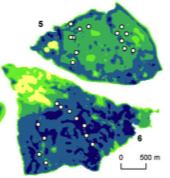Low density lidar provides valuable plot-level forest data
 Thursday, December 13, 2012 at 7:56PM
Thursday, December 13, 2012 at 7:56PM Jakubowski, M., Q. Guo, and M. Kelly. 2013. Tradeoffs between lidar pulse density and forest measurement accuracy. Remote Sensing of Environment. 130: 245–253.
 lidar density examples: 9 - 0.01 pl/m2
lidar density examples: 9 - 0.01 pl/m2
Discrete lidar is increasingly used to analyze forest structure. Technological improvements in lidar sensors have led to the acquisition of increasingly high pulse densities, possibly reflecting the assumption that higher densities will yield better results. In this study, we systematically investigated the relationship between pulse density and the ability to predict several commonly used forest measures and metrics at the plot scale. The accuracy of predicted metrics was largely invariant to changes in pulse density at moderate to high densities. In particular, correlations between metrics such as tree height, diameter at breast height, shrub height and total basal area were relatively unaffected until pulse densities dropped below 1 pulse/m2. Metrics pertaining to coverage, such as canopy cover, tree density and shrub cover were more sensitive to changes in pulse density, although in some cases high prediction accuracy was still possible at lower densities.
 forests,
forests,  last chance,
last chance,  lidar,
lidar,  remote sensing,
remote sensing,  snamp
snamp 



